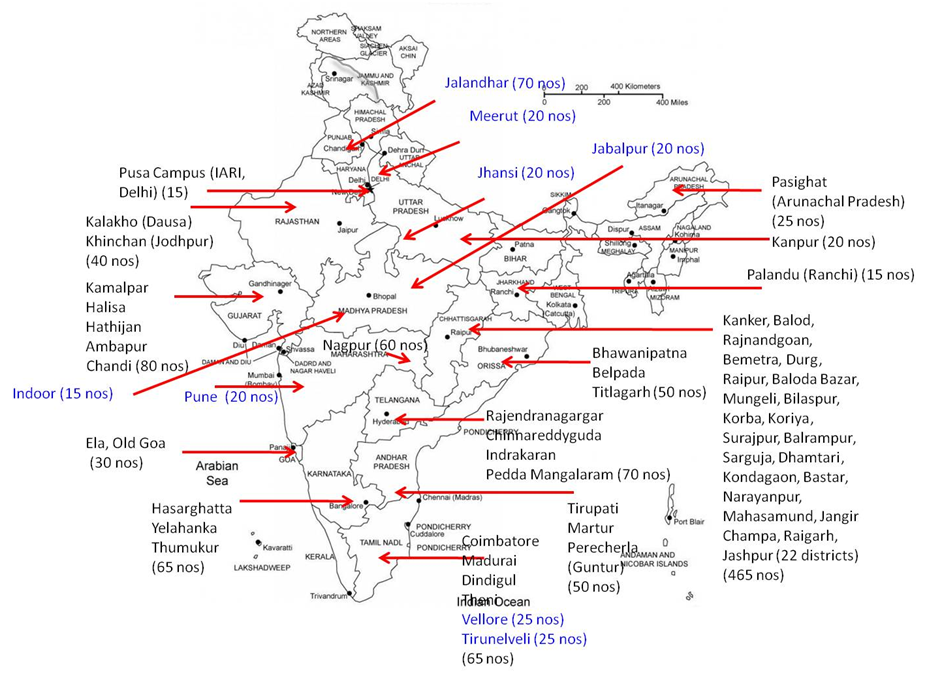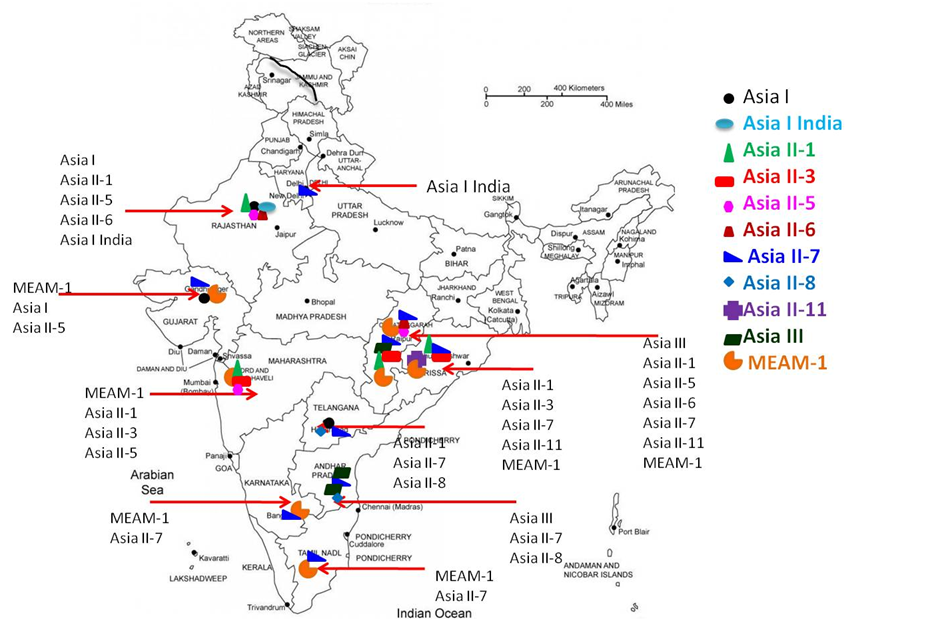Entomology and Nematology
Genetic diversity of whitefly, Bemisia tabaci in PAN India
Whitefly, Bemisia tabaci is a polyhagous pest infesting wide variety of crop plants, weeds, ornamental plants etc. in more than 82 countries including India. It causes significant direct damage to many crops through desaping and indirectly by transmitting number of plant viruses belongs to Geminiviruses. Plant virus transmission efficiencies and host preferences of various genetic groups of B. tabaci have been reported to be significantly varying which will have consequential implications on seed and commercial production of crops. Therefore, it is essential to determine the population genetic structure of various genetic groups of B. tabaci and their transmission efficiencies with respect to begomoviruses in various crops across India.
A total of 625 whitefly samples were collected from fifteen different host plants in 41 sites covering 12 different states including Tamil Nadu, Maharashtra, Chhattisgarh, Jharkhand, Gujarat, Uttar Pradesh, Delhi, Goa, Arunachal Pradesh, Madhya Pradesh and Punjab (Fig. 1). The host plants covered were brinjal, tomato, potato, chilli, bhendi, cotton, soybean, cowpea, bitter gourd, sunflower, ridge gourd, basil, chrysanthemum, congress weed and tobacco. Total genomic DNA was isolated from 330 individual whiteflies. A total of 282 mt COI gene sequences were generated, edited and analysed using standard analytic tool MEGA 6.0 and compared with references sequences to identify genetic groups.

Figure 1. PAN India survey for collection and identification of genetic group of whitefly
Genetic group names were assigned based on the similarity with the reference sequences reported across world. A total of 11 distinct genetic groups were identified in south, central and few north Indian states (Fig. 2). We reported three new genetic groups, Asia II-3, Asia II-6 and Asia III from Chhattisgarh, Andhra Pradesh and Maharashtra for the first time in India. Asia I mostly recorded in central and northern states while Asia III was recorded exclusively in Chhattisgarh and Andhra Pradesh. Asia II-7 is widely distributed in South and Central India. However, MEAM-1 most popularly known as Biotype B has been widely distributed across the regions.

Figure 2. Genetic diversity of whitefly in PAN India
Native biocontrol agents for management of Lepidoptera pests
Native biocontrol agents are potential to manage Lepidoptera pests. Egg parasitoids especially Trichogramma spp., belonging to the order Trichogrammatidae reported over 230 species are widely used to the biocontrol of eggs of over 200 insect species of moths and butterflies pests of crops. The sentinel Corcyra egg trap card were tied in 63 places in 18 crop and non-crop ecosystems, belonging to 22 districts of Chhattisgarh during 2019 (Fig. 3).

Figure 3. Sentinel egg card trap for recovery of native egg parasitoids in different districts of Chhattisgarh
During surveys, 20 wild populations or eco-types of Trichogramma were recovered and cultured under laboratory condition. Out of 20, 11 eco-types were identified as T. japonicum and eight were identified as T. chilonis. T. japonicum and T. chilonis are predominantly prevailing species in Chhattisgarh (Fig. 4).

- The regression model was developed for estimating yield losses due to various biotic stresses in lowland rice: Yield=6.315-0.00897(DI)-0.0927(IP)-0.01752(WD) (DI-Disease incidence; IP-insect pest incidence; WD-Weed density)
- First report of rice root knot nematode inChhattisgarh state
- Three species of stem borer including yellow stem borer [Scirpophagaincertulas(Walker)] (Lepidoptera: Pyraustidae), stripped stem borer, [Chilosuppressalis (Walker)] and white stem borer [Scirpophagainnotata (Fab.)] (Lepidoptera: Pyraustidae) were recorded in low-land rice. Among them, yellow stem borer (YSB) is a predominant species
- Two broods of yellow stem borer were recorded on 33rd and 35th meteorological standard week (MSW) during kharif and on 10th and 16th MSW during summer, respectively
- Split releases of Trichogramma japonicum @ 50,000 wasps/release/ha on 32nd, 39th, 46th, 53rdday after transplanting (DAT) of rice seedlings at weekly interval during kharif and on 14th, 21st, 28th, 35th DAT during summer are optimum number and time of releases to manage yellow stem borer
- Three kairomones, n-hexadecanoic acid, n-octadecanoic acid and octadecane detected from female whole body extract of YSB were potential to enhance the biocontrol activities of T. japonicum against rice YSB
- Application of kairomone Gel formulations, 24 hr later to each release of T. japonicum @ 50,000 wasps/ha × 4 releases on 32nd, 39th, 46th, 53rd DAT at weekly interval during kharif resulted the incidence of dead heart (3.4%) and white ear (0.5%) in T. japonicum + octadecane (released 24 hr later) treatment and 4.4% dead heart and 0.8% white ear in T. japonicum alone treatment (without kairomone Gel formulations; positive control) as compared to control (no kairomone and wasp release; negative control) with 9.6% dead heart and 1.8% white ear which reduced dead heart and white ear incidences over T. japonicum release alone by 10.41 and 16.66%, respectively
- During four surveys in 22 districts of Chhattisgarh, 16 native egg parasitoid including Trichogramma japonicum and T. chilonisand 12 native Bacillus thuringiensis were isolated, identified and bioassayed
- Out of 280 individual B. tabaci subject to DNA and PCR analysis, presence of 12 genetic groups of whitefly belonging to Asia I, Asia II-1, Asia II-5, Asia II-7, Asia III, Middle East Asia Minor 1 (MEAM 1) in South India and Central India (10 states) have been identified
- High infestations of pink stem borer (PSB) was recorded in late sown wheat crop as compared to timely sown crop. Among nine districts of Chhattisgarh surveyed, maximum infestation of 10% at Raipur and minimum of 1-2% at Sarguja was recorded. Three varieties and three germplasm were found resistant to pink stem borer.
- Soil application of diatomaceous earth @ 300 kg/ha induced the systemic acquired resistance in wheat against pink stem borer by enhancing total phenols and defense enzymes (peroxidase, polyphenol oxidase, phenylalanine ammonia lyase and Beta1-3 glucanase)
- Secondary metabolites of Chromobacteriumare found to have larvicidal (35%), pupicidal (29.3%), ovicidal (26.2%) and antifeedant activities (38.8%) against Lepidoptera pests
- Three and 16 pigeonpea germplasm were recorded to be moderately resistant to pod borer (Helicoverpa, Maruca) and pod fly, respectively while 12 Lathyrus germplasm were moderately resistant to thrips
- Developed Lathyrus app and Interactive Educational Multimedia Module on Biotic Stress Management in rice












